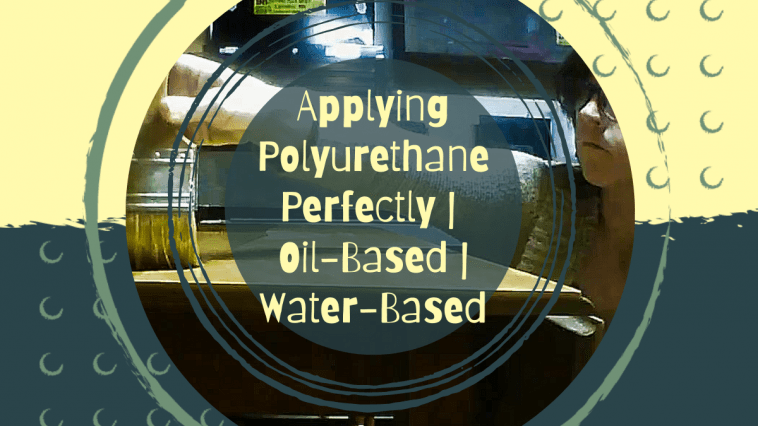
Hi there! Thanks for stopping by the KRay Custom Refinish Blog today as I discuss the many questions surrounding applying polyurethane to wood furniture.
Applying polyurethane perfectly is something that takes a bit of time to master, and depends on a few factors.
Oil vs. water-based is one of the biggest ones. So I’ll begin with an overview of the 2 different types, pros, cons, etc. Then I’ll show you the best method for applying them both and explain exactly how to apply polyurethane without brush marks & bubbles.
I’ll go over how to apply polyurethane to either natural wood or freshly stained/painted wood. If you’re interested in learning how to apply polyurethane over a piece that was previously finished, head over to my post on Repairing Damaged Finishes. I cover polyurethane/varnish, shellac, and lacquer finish repairs.
Although I don’t recommend it, I know some of you may be interested in applying your polyurethane over an existing clear finish.
All I can say is please, please, please make sure you know what the existing finish is before you attempt the following method for applying polyurethane.
Again, you can find info on testing the finish of your piece in my Repairing Scratched Clear Coats post. Here’s a little infographic from that post to help with that if you’d rather not read the entire post:
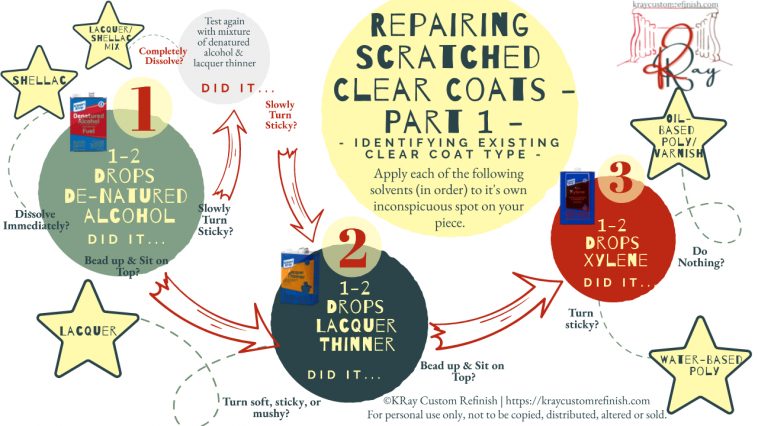
If the piece has lacquer on it, you will need to completely remove it before applying varnish or polyurethane. Polyurethane and lacquer are not compatible with one another.
If the piece has oil-based polyurethane on it, you can apply more oil-based polyurethane on top of it.
If the piece has water-based polyurethane on it, you can apply more water-based or oil-based polyurethane over it, as long as the water-based polyurethane has completely cured. (30-60 days)
If the piece has shellac on it, unless you know for sure that it is de-waxed shellac, don’t put polyurethane over it. Pre-mixed shellacs are usually not de-waxed, and not much will stick to wax. You can purchase this:

which is a 100% wax-free formula. Apply a thin coat over the original shellac and let it dry. Then you can apply oil-based or water-based polyurethane on top of that without issue.
For the best result, start with a freshly sanded & stained/painted piece without any other clear finishes on it.
Be sure to wait for the minimum dry time necessary for the particular stain or paint that was applied to the piece. I prefer to wait at least 24-48 hours before applying poly.
If you don’t wait long enough, you might end up pulling off some of the wood stain or paint while you’re applying the polyurethane.
Water-Based Poly vs. Oil-Based Poly – Pros and Cons
There are good and bad elements of both water and oil-based polyurethanes. Your final decision depends on the piece you’re working on’s color, size, shape, and where the piece will be– indoors or outdoors.
| Type | Pros | Cons |
|---|---|---|
| Oil-Based Polyurethane | Easier to Apply. Slightly more resistant to scratches, moisture, and damage from heat. Amber cast brings warmth to darker wood colors. | Amber cast may change the coloring of your piece. Color Darkens over time. Difficult Cleanup. Longer Dry Time. Strong Odor. |
| Water-Based Polyurethane | Fast dry time. Easy soap & water clean-up. Dries completely clear. Little to no odor. | Difficult to apply without brush marks. Less resistant to scratches, moisture, and heat. Dark-colored woods may appear cold and dull. |
Not sure which to choose? Let me solve your problem!

| Pros | Cons | |
|---|---|---|
| Waterborne Oil-Modified Urethane | The self-leveling formula makes it easy to apply without brush marks. 2 Hour Dry Time. Low-Odor Formula. Easy Soap & Water Clean-Up. A slight amber tone adds warmth to woods but doesn’t discolor light woods as much as oil-based. Outstanding wear and durability | None! |
First off, I’ve recommended ZAR products before, they truly are the best for wood stains and clear finishes. Their Oil-Modified Urethane is the best of both worlds when it comes to polyurethanes. Fast dry time, low odor, and easy cleanup were enough to sell me on it, but those aren’t even the best things about this stuff.
It’s incredibly easy to apply without brush marks or bubbles popping up. I don’t even recommend thinning it before application as I will be for the oil-based poly! Check it out, it solves pretty much every problem there is with both other types of poly.
If you’ve landed on this post you most likely already have a poly on hand that isn’t the oil-modified type as it’s not very well known.
So don’t worry! I’m still going to show you exactly how to apply both the water and oil-based polyurethanes for the perfect finish.
If you do have the Oil-Modified Water-Based Polyurethane, follow the steps for Water-Based Polyurethane Application.
First up: Oil-based polyurethane. Using Water-Based Polyurethane? Skip Ahead to Applying Water-Based Polyurethane Perfectly.
Prep Before Polyurethane Application – What You’ll Need
If you’ve reached the polyurethane point of your project, it’s safe to assume that you’ve sanded your wood piece properly, stained or painted it, and it’s ready for the final finish. If not, check out my posts on How to Sand Wood Furniture, Preparing Wood For Staining, and How to Stain Wood.
You shouldn’t need sandpaper any rougher than 120 grit once you’ve reached this point. Anything lower would remove the wood stain or paint and sand right through any coats of polyurethane.

You may need to use a sanding block to scuff up the surface before application.
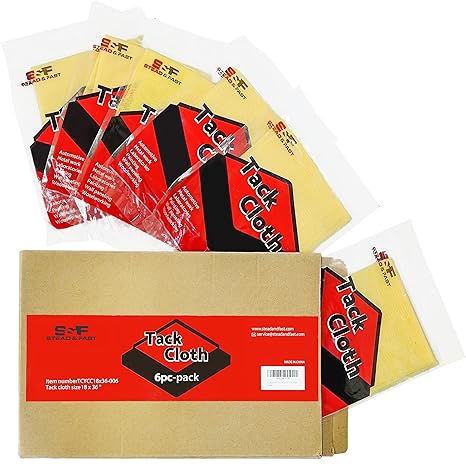
A tack cloth will remove any sanding dust left over after scuff sanding. You want to remove any dust completely before applying your poly. I like to use an air compressor to blow any dust out of the cracks or crevices. Dust can completely ruin a piece if it’s left on the surface, or lands on the poly while it’s wet, so be sure to remove any trace of it beforehand!
Finally, to be sure you’ve cleaned your piece completely. I recommend wiping the entire piece down with a cloth dampened in mineral spirits.
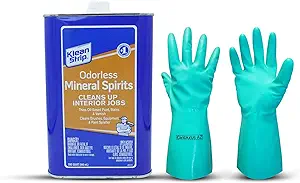
Skip Ahead to Water-Based Polyurethane Application – What You’ll Need.
Oil-Based Polyurethane Application – What You’ll Need



How To Apply Polyurethane Step by Step – Applying Oil-Based Polyurethane Perfectly
First off, wipe your entire wood surface down with mineral spirits.
This will remove any sanding dust, dirt, wax, or anything else that may have ended up on the surface.
Wait until the mineral spirits have thoroughly dried before attempting anything else.
Mineral spirits may feel oily as you apply them to the surface. Don’t worry, it won’t affect the polyurethane finish as long as you wait for the spirits to completely evaporate from the wood. Usually takes no longer than 30 minutes.
While you wait for the wood to dry, create your DIY Wiping Poly.
Any brand/strength oil-based polyurethane can be used, but there is one rule to make sure you follow:
Don’t thin semi-gloss or satin polyurethane as they contain flattening agents. According to FineWoodworking, “varnish containing flattening agents should not be thinned beyond what it calls for on the can. The flattening agents will not stay in suspension and white streaky areas may result.” If you want a satin or semi-gloss finish, you’ll need to do a full-strength final coat with a brush.
For this coat’s wiping poly, mix it 50/50 with mineral spirits. Stir gently with a stir stick and try not to create too many bubbles throughout the process. Don’t shake Polyurethane. Ever.
Using a lint-free cloth, or old t-shirt, dip into the wiping poly, lightly coating it.
You don’t want the rag to be soaking wet with poly. But enough to apply a very thin coating to your surface. As long as it’s a brand-new container, you can lightly press the rag against the side of it to wring some of the poly out. Just be sure everything you do is slow and light, you don’t want to stir up too many bubbles in the poly.
For the first 2 coats, you just want to get the poly on. The best advice I’ve read compared it to a “kid working as a busboy quickly cleaning off a table.“
Swirl it on lightly, don’t try to apply it in straight strokes. If you find that you missed a spot, don’t try to fix it. Just cover the table the best you can and then do not touch it. The surface shouldn’t look like it’s soaking wet when you’re finished. You also shouldn’t see a bunch of brush/cloth marks if you’ve done it correctly.
Below is an example of correctly applying the 1st 2 coats of wiping poly.
Wait until the surface is dry to the touch before applying your second coat.
Try lightly touching the surface with your finger. If nothing comes off, you can apply your second coat the same way as your first.
After the first two coats, wait 24-48 hours.
The longer you let it sit, the better.
After letting it cure for as long as possible, you can lightly sand the surface with 320 grit sandpaper.
Just lightly sand it until it’s flat, don’t go overboard with sanding. Yes, you’ve applied two coats, but at only half-strength. This means there’s only close to 1 full-strength coat on the surface at this point.
Remove all sanding dust, then apply 2 more coats the same as the first 2.
Same way as before, lightly swirl it on.
After these 2 coats, again, lightly sand the surface with 320 grit sandpaper.
If there are any serious flaws or cloth marks, you can lubricate the 320 wet-dry sandpaper with water and lightly sand the surface.
We’ve now completed 4 light coats of wiping poly, amounting to 2 full coats of regular polyurethane.
For some pieces, this is enough protection. But I’d recommend at least 1 more full coat for even the pieces used less frequently.
For the next coats, you’ll need to mix up a new Polyurethane: Mineral Spirits Ratio, 5:1.
4 parts Polyurethane to 1 Part Mineral Spirits. The 5:1 ratio leaves a bit thicker of a coat, for more protection, but still flows easier than full-strength polyurethane.
You should also use a paintbrush for these coats as well. That Natural Bristle paintbrush I recommended earlier– you were wondering when that would come into play, right?
Starting with a clean brush, dip into your thinned poly mixture.
Coat the brush, then let it hang over the container for a bit and drop off some of the excesses. Try not to touch the brush to the sides of the container at all as that may introduce bubbles or dried poly that has settled on the edge.
Once it has stopped dripping, bring the brush to the center edge of your surface and drag it to the edge.
Slowly and lightly drag the brush across the surface.
Next. moving in the opposite direction, start a little to the right of where you started the first stroke. Drag the brush back to the opposite edge of the surface.
So your first stroke moves to the right side of the surface. The second stroke moves toward the left side of the surface.
Dip the brush into the poly again, let drip, and repeat.
Starting in the middle of the surface directly below your first line, slightly overlapping it by 1/2″ or so. Move toward the right, then back to the center, then to the left.
If that confuses you this video may help:
Once you’ve covered the entire surface, don’t dip your brush again. Use the dry brush to “feather” the entire surface.
Lightly drag the tip of the brush down each line from left to right. You don’t want to apply much pressure at all. Just softly scrape to spread out any puddling or bubbles. One time for each line and nothing more!
Then leave it alone for 24 hours.
Do not try to fix any spots with brush marks or bubbles. Just go clean your brush with mineral spirits and leave the area for 24 hours.
After 24 hours, sand with 320 wet-dry sandpaper.
For serious brush marks or bumps, wet sand with a little bit of water and a drop of dish detergent. Use a sanding block, not a power anything.
Once you’ve got it as smooth as possible, spray and wipe down the surface until it is completely dust-free. Then leave the area.
Don’t return to the work area or have anyone else around the work area for at least 2 hours. This will help keep the area completely dust-free.
You’re on to the final, final coat now. So take a bit more care in everything you do for this one if you want it to truly come out perfectly. NO DUST!
Using the same mixture you used for the last coat, roughly 5:1, you’re going to wipe on this final coat with a rag.
Make sure you keep a couple of extra rags nearby also, you will need a dry rag and the rag you use to apply the poly. Wipe the poly onto a small area of the surface.
After a few moments, use a dry rag to wipe the poly off of the area. Then continue wiping on the rest of the surface.
Use a clean, dry rag to wipe the poly off. This seems pointless, I know. But in fact, you’re not wiping off all of the poly. A thin layer will be left on the surface of the project and will leave you with a perfectly smooth result. Let it dry and voila! If you’ve done everything correctly, your surface should be glass-smooth and gorgeous!
So Many Projects Going At Once, You Don’t Know What To Do Next??

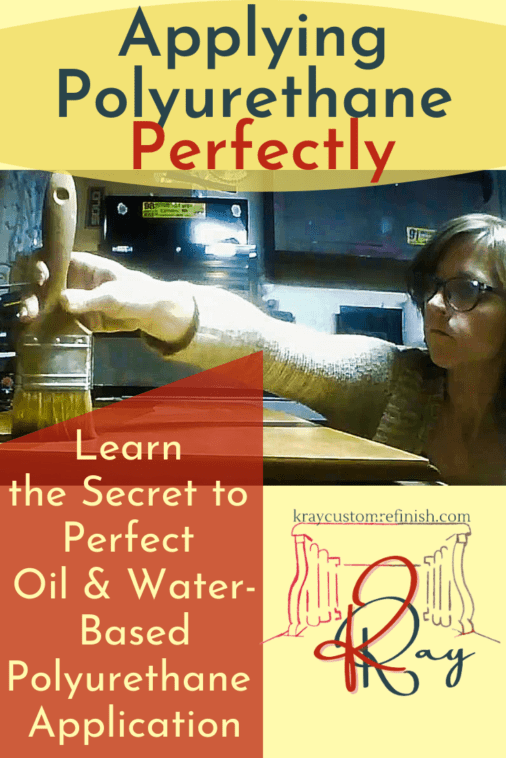




Such an informative article! All the information provided by you is really very helpful. By using tack cloth you can easily remove small dust particles from the surface and it also gives you smooth paint finishing. Thank you for sharing! Keep posting!
Thanks so much for your comment, glad you enjoyed my post 🙂 I 100% agree tack cloths work wonders when removing dust for applications like these. I’ll be sure to add that to my post!